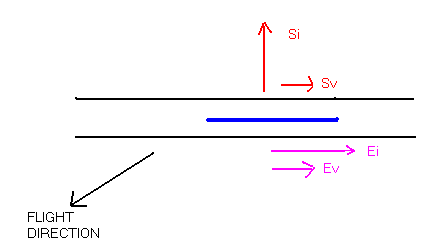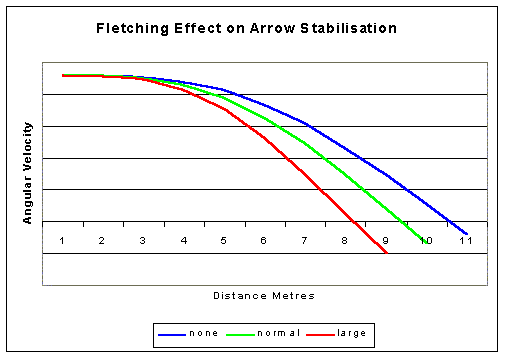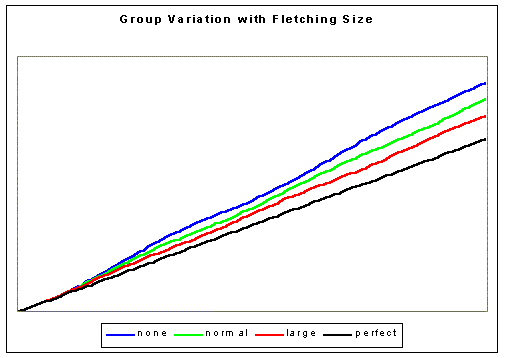 The following diagram is a simpified illustration of the drag forces on a (straight) fletching. The arrow is assumed to be rigid and not vibrating.
The following diagram is a simpified illustration of the drag forces on a (straight) fletching. The arrow is assumed to be rigid and not vibrating. The following diagram is a simpified illustration of the drag forces on a (straight) fletching. The arrow is assumed to be rigid and not vibrating.
The following diagram is a simpified illustration of the drag forces on a (straight) fletching. The arrow is assumed to be rigid and not vibrating.
Drag on the fletching surface comprises an inertial drag force (Si) at a right angle to the fletching surface and a viscous drag force (Sv) parallel to the fletching surface. Drag on the edge of the fletching comprises inertial (Ei) and viscous (Ev) forces both effectively parallel to the fletching surface. Under the flow conditions for an arrow the inertial forces are many thousands of times greater than the viscous forces and the latter can in practice be ignored. A drag force at a right angle to the arrow shaft generates a torque which acts to rotate the arrow. A drag force parallel to the arrow shaft (and hence running though the arrow center of mass) acts only to accelerate or decelerate the arrow.
In summary then the drag force on the surface of the fletching acts to rotate the arrow (straighten it up) and the drag force on the edge of the fletching acts to change the arrow velocity. (For the case where the fletching is not straight or fitted at an angle to the shaft axis see the section on spinning arrows).
If you put larger fletchings on an arrow then it hits the target lower down. An (incorrect) explanation often given for this behaviour is that it results from the increase in the actual drag on the fletching surface area increasing the overall arrow drag. (Simple arrow trajectory models assigned the effects of fletching area on the pile and shaft drag into an 'imaginary' fletching drag). The correct explanation is given in the section on bareshaft tuning.
The main effect of fletching size is that the larger the surface area of the fletching then the faster an arrow will 'straighten up'.
The diagram below illustrates the different flight behaviour between two identical arrows shot with identical initial flight parameters. The only difference between them is the size (area) of the fletchings, one being small and the other being larger but a sensible size.
 The arrow with the larger fletching
oscillates much faster than the smaller fletched arrow. As a consequence
the distance the arrow gets pushed sideways is reduced with the larger fletching.
The other benefit you get from the larger fletching is that because the range
of arrow offset angles is smaller there is less "flying sideways" and
you get lower contribution to the overall drag from the arrow shaft. The curve of the mean arrow path is therefore reduced.
As the fletching gets larger, and hence heavier, it moves the centre of gravity
of the arrow back towards the nock. This reduces the proportion of shaft drag
that is acting as a fletching and overall reduces the arrow turning efficiency
of both fletching and shaft drag as the torque lever arm is shortened. The area of the fletching contributes to the overall cross sectional area of the arrow
and hence to the wind drift behaviour of the arrow.
The arrow with the larger fletching
oscillates much faster than the smaller fletched arrow. As a consequence
the distance the arrow gets pushed sideways is reduced with the larger fletching.
The other benefit you get from the larger fletching is that because the range
of arrow offset angles is smaller there is less "flying sideways" and
you get lower contribution to the overall drag from the arrow shaft. The curve of the mean arrow path is therefore reduced.
As the fletching gets larger, and hence heavier, it moves the centre of gravity
of the arrow back towards the nock. This reduces the proportion of shaft drag
that is acting as a fletching and overall reduces the arrow turning efficiency
of both fletching and shaft drag as the torque lever arm is shortened. The area of the fletching contributes to the overall cross sectional area of the arrow
and hence to the wind drift behaviour of the arrow.
The fletching, from the point of view of good arrow flight can therefore be too big or too small with the right size somewhere in the middle. The lighter the material the fletching is made of the better because of the weight effect.
When the arrow leaves the bow it is vibrating as a result of the Archers Paradox effect. A large part of this vibrational energy is dissipated by drag on the fletching surface and the section of shaft that acts as fletching. As the drag depends on the area,the larger the fletching the faster this energy is removed. i.e. the faster the arrow vibration is damped.
The sensitivity of the arrow to wind gusts is also dependant on fletching size. When a gust of wind hits an arrow as well as blowing it downwind it also rotates the arrow. The amount of rotation and the recovery of the arrow from the rotation depends on the fletching area. When the arrow is rotated by a gust the arrow angle results in the sideways drag force on the arrow acting to move the arrow in the upwind direction i.e. to some extent arrows are self compensating for gusts. With respect to tolerance of wind gusts fletchings can be too big or too small, it is a balance between the amount the arrow is rotated and moved sideways and the recovery time. You can have the odd situation that a wind gust from the left ends up with the arrows hitting the target on the left if the recovery time is too long.
Feather fletchings are lighter then plastic fletchings for the same area. If two identical arrows are shot with similar sized fletchings, one having feather and one having plastic fletchings then at short distances the the feather fletched arrow will probably hit higher. (It leave the bow at a higher speed as the arrow is lighter). In the long run however the plastic fletched arrow will probably end up hitting the target higher up as the drag from the plastic fletching surface is lower. (The feather fletch is probably thicker/less straight than the plastic one).
When an arrow leaves it can be rotating (poor tuning or poor shot). If during the shot the push on the arrow from the string does not run through the arrow's centre of gravity then a torque is generated on the arrow creating rotation.
 The following diagram illustrates the difference in behaviour between an arrow with rotation coming off the bow and one with no rotation, all other things being
equal.
The following diagram illustrates the difference in behaviour between an arrow with rotation coming off the bow and one with no rotation, all other things being
equal.
The arrow with rotation ends up with a much larger sideways displacement on the target than the one with none. This is an important aspect in understanding arrow flight. How far the arrow hits from the middle of the target principally results from the initial arrow rotation. The direct effect of the arrow fishtailing/porposing is by comparison relatively small.
You can look at the flight of an arrow as being in two phases. The first phase occurs just after the arrow leaves the bow with rotation from the shot. Because the arrow is at an angle to its direction of flight there is a component of the total drag force acting sideways to the direction of flight. Because the arrow is rotating and hence the offset angle keeps increasing this sideways drag force keeps increasing. The arrow is therefore accelerated sideways until the action of the fletchings removes this initial rotation from the arrow i.e. brakes rotation of the arrow to a halt. The arrow at this point has a velocity in the direction in which it was initially shot plus a sideways velocity. These two velocities add together and as a result the overall direction in which the arrow is travelling is changed. At this point the arrow then enters the second phase of flight which is the oscillation about a mean path discussed earlier. The effect of the first phase is to rotate the initial direction of flight the arrow has in the second phase. This is illustrated by the black arrows in the above diagram.
The two phases of flight are easily seen if you stand behind an archer while an arrow is shot. The arrow seems almost to leap sideways out of the bow in the first phase, what archers often call "the kick". After the kick the arrow seems to fly straight to the target ( second phase). Frequently the oscillations of the arrow in the second phase of flight are too small to see.
Modern carbon arrows with their FOC's of around 14-17% will fly with perfect stability without any fletchings fitted, so why bother with fletchings at all. You get less wind gusting problems with no fletchings. The answer is that to minimise groups you need to stabilise the arrow flight as fast as possible - this is the primary function of fletchings.
If an arrow is shot from a bow with a poor setup/poor shot it leaves the bow rotating with some angular velocity. Until this angular velocity is removed (the arrow flight is 'stabilised') the arrow flies in a curved path. The longer it takes for the arrow to stabilise the bigger the resulting angle between the direction the arrow was shot and the direction the arrow ends up travelling.

The graph illustrates how the 'stabilisation distance' varies with the fletching size. It shows the variation of arrow angular velocity with distance for three identical/identically shot arrows. The only difference between the arrows is the fletching size (bareshaft, typical fletching,large fletching). The arrow is stabilised when the angular velocity drops to zero (crosses the 'x' axis). The larger the size of the fletching the faster the arrow stabilises.

This graph illustrates the consequences on group size of how fast the arrow stabilises. Although the difference in angle between the required direction (the black line) and the 'after stabilisation' direction is small, small angles at large distances can result in quite large lateral displacements, certainly enoough to cause you points. (note at this scale the effect of the arrow fishtailing is not very obvious).
The arrow fletchings will always try to rotate an arrow to the position where there is no fletching torque i.e. the position in which the net air flow direction is along the arrow shaft. The net air flow velocity is the sum of the arrow velocity and any wind velocity. The "natural" orientation of the arrow depends on any cross wind. The following diagram illustrates the natural arrow positions in the presence of a cross wind and with no crosswind.
 If there is no cross wind then the
net wind direction runs directly from the archer to the target i.e. the arrow
will always be trying to fly straight. If there is a cross wind then
the natural arrow angle will be at an angle to the arrow direction of flight.
The arrow's tail will "hang out". At its natural angle there is no net
torque on the arrow and there is no net sideways component of the drag from the shaft. Because the arrow flies at an angle in a cross wind the drag in the direction of
arrow flight increases and the arrow will hit lower down on the target. Even
at its natural angle there is a sideways drag force component on the arrow from the
pile and the edges of the fletchings accelerating it in the downwind direction.
If there is no cross wind then the
net wind direction runs directly from the archer to the target i.e. the arrow
will always be trying to fly straight. If there is a cross wind then
the natural arrow angle will be at an angle to the arrow direction of flight.
The arrow's tail will "hang out". At its natural angle there is no net
torque on the arrow and there is no net sideways component of the drag from the shaft. Because the arrow flies at an angle in a cross wind the drag in the direction of
arrow flight increases and the arrow will hit lower down on the target. Even
at its natural angle there is a sideways drag force component on the arrow from the
pile and the edges of the fletchings accelerating it in the downwind direction.
As the arrow loses horizontal speed to drag in the course of its flight the strength of the cross wind increases relative to the air flow from the arrow speed. As the arrow flies in a crosswind therefore the natural angle steadily increases, the arrow's tail swings out.

To compensate for the downwind drift of the arrow archers either aim-off or adjust the windage on the sight. The purpose of aiming off is to give the arrow a horizontal velocity in the upwind direction to balance the downwind drift. Aiming off also changes the arrow's flight characteristics as the arrow is now leaving the bow in a different direction. The first phase of flight as defined above becomes much more complicated as in addition to the arrow offset angle and arrow rotation from the shot the effect of the cross wind, the arrow's aim off velocity and the arrow aim off angle all interact to define the arrow behaviour. There may be more than the two phases of flight identified above with a cross wind as, when oscillating, there is the possibility that the arrow could rotate enough for the sideways drag from the arrow's forward velocity to reinforce the cross wind drag. The following diagram illustrates the effect on arrow flight of aiming off.
Where on the arrow shaft should the fletchings be placed to get the most out of them? What you want the fletchings to do is rotate the arrow as fast as possible. You want the drag torque on the fletchings to produce the maximum rotational (i.e. angular) acceleration. The angular acceleration depends not only on the torque on the arrow but also on how easy it is to turn it. How easy it is to turn depends on the point about which it rotates. Hold a long rod at the weight end and its easy to twist about. Hold it where it screws into the bow and its much more difficult to twist. The "rotatability" of an object is called its moment of inertia. The angular acceleration you will get is the applied torque divided by the moment of inertia. Both items depend on the point of rotation of the arrow. It turns out that to maximise the angular acceleration the fletching should be located as near the nock end of the arrow as possible.
Last Revision 1 July 2009